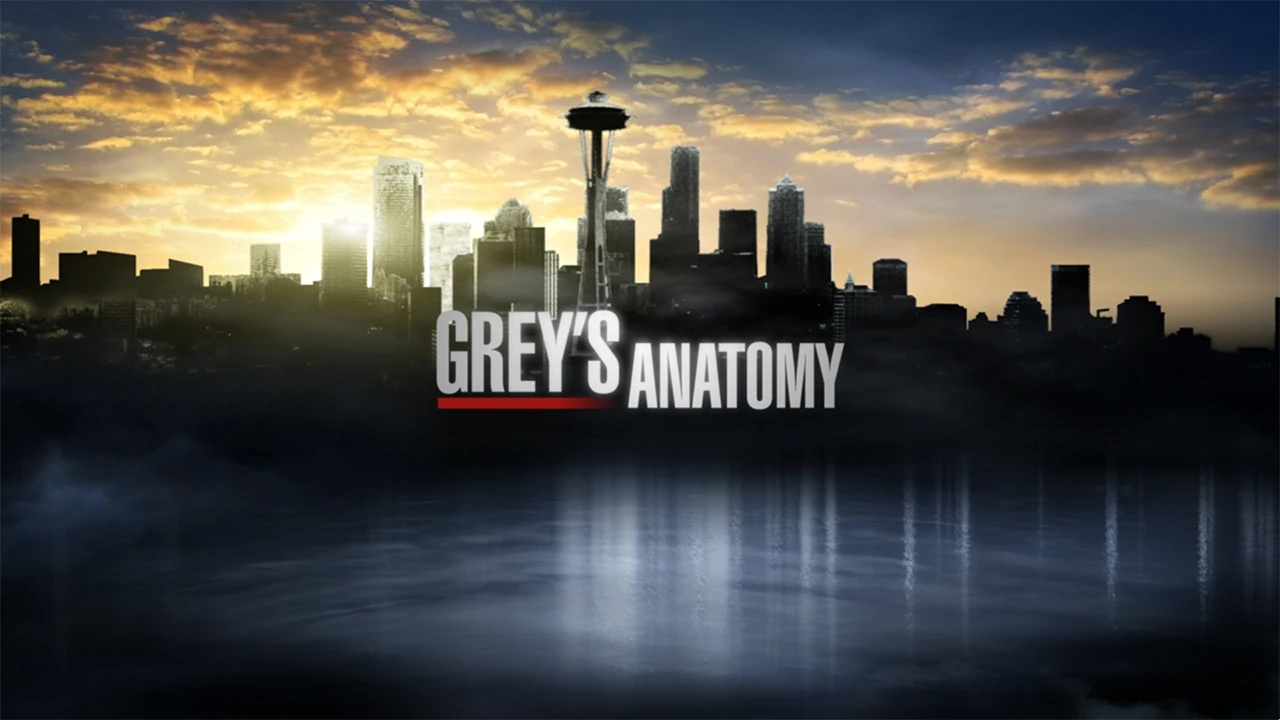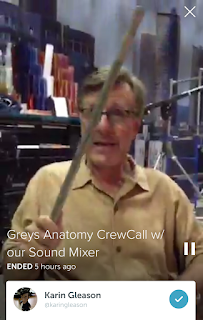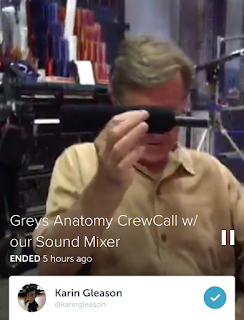 |
| *I do not own this logo. It is owned by ABC's Grey's Anatomy |
Brian Harms: Production Designer
*Content written below is based on what was said directly from the periscope session in a mix of my words and his.
Additionally, Harms provides technical support for other departments. For example, we learned last week by Mimi Melgaard (costume designer of Grey's Anatomy) that she keeps multiples of the same outfits for multiple takes, and the same goes for the popular scrub caps the actors wear on the show. Character Derek Shepherd wears a very popular ferry boat scrub cap. Well, they only had one, and the fabric to make more was discontinued. So Brian Harms had the scrub cap disassembled. Then he scanned the cap into his computer, photoshopped and cleaned up the image in order to send out to print new fabric so that more caps can be made. Do you realize what that means? Brian Harms was the person who saved the ferry boat scrub cap and allowed it to live many more days on the show. As you saw at the end of season 11 even though Derek Shepherd is gone, Meredith Grey is keeping his spirit alive by wearing that famous cap herself. "It's a beautiful day to save lives"
 |
| *I do not own these photos. Belong to ABC's Grey's Anatomy |
The top position for the art department is Art Director. It has its own union, Art Directors Guild (ADG). In order to be allowed to use the title "production designer," it has to be petitioned to the ADG. "It is a protected honorary title." Contractually not every show or production needs a production designer because the needed tasks can be managed by one art director. Since Grey's Anatomy is such a large show with so many components it requires both titles, an art director and a production designer.
*If you want to learn more about the two positions the ADG website goes in detail on the two jobs. A link to the direct page for the info is here.
How did you come to this job?
Harms explains that being born in such a small town (Lander, Wyoming) he didn't know that what he's been doing for years was an option, he didn't know what to do for a career. He knew that he had to go to college, but he didn't know for what so he ended up going to school for business since that's what he was told most people were doing. He started as a business major, then biology resources (with a goal of a career as fish and game officer or Forrest Services). Then he ended up getting a music scholarship (for voice & saxophone). He started working in the recording studio, then doing sound for theater, then sound reinforcement. When it was realized that his dad was a wood working teacher he was asked to work part time at the scene shop, he then started working for a touring company doing national tours as a technical director. He was doing all this while still going to school. He realized he liked what he was doing so much that he got his Bachelors of Fine Arts in Theater. Later he decided to go to grad school getting his Master of Fine Arts in theater scenic design. John Shaffner, (University of Montana alum and award winning art director for his work on shows like George Lopez and The Big Bang Theory) after Harms worked as an assistant on some of his projects, invited Harms to move out to Los Angeles to work. Not ready to take the plunge he didn't go, but 10 years later after getting his Masters he decided that he was ready. He ended up never working for Shaffner, but because Shaffner introduced him to people in the business he was able to get jobs here and there and hustled doing many non-union jobs until he got to where he is now. Brian Harms got his Associates of Arts from Central Wyoming College, his Bachelors of Fine Arts from the University of Montana, and his Masters of Fine Arts from Pennsylvania State University.
What are some skills that are needed to be a production designer?
"Every show is different and requires something different of you." Harms states that so much of the job is logistics, thinking something through ("what is it going to take to accomplish this objective"). Karin Gleason adds that if a tough situation arises it's not about knowing how to make everything happen, you have to know where to do the research to attack the task at hand. You also need a solid grasp of architecture, decorating, and style. Brian Harms makes an emphasis on how a portion of the job is script analysis (discussing characters), which his past work in theater and classes he's taken in acting and directing has helped him do.
What is the best part of your job?
"Most of us must be masochists, because it's such a tough environment with very long days." Harms contributes his co workers as one of the best parts of his job. The people he works with makes the job a lot better then what it seems. Some of the people he has worked with have become his best friends. Another great aspect of his job is feeling "the elation of the achievement [of overcoming a tough situation and] how it keeps us coming back for more." See, part of his job is getting put in situations that almost seem impossible, they have to figure out how to make things work in an unbelievably small amount of time. Gleason adds that it's the joy of seeing something through from beginning, middle, to end. "Most people will never know what it took to make a Grey's Anatomy episode work," says Harms.
What advice would you give to someone trying to go into your same profession?
Harms jokingly states, "RUN!" This job requires you to have a real passion, not just a want to work for a giant hit show. You really have to like designing sets and be okay with doing things yourself, and be able to stick it out through hard lessons until you are entrusted with harder jobs, and earn a little more. It's a tough job because there are no straight paths to get you to the job you want like maybe a career as a lawyer or a doctor. Brian Harms recommends an internship the Art Directors Guild offers, check out their website for more information: http://www.adg.org/
What is a favorite set you designed for the show?
Since his favorite set is in the unaired season 12 Harms couldn't answer the question, but Karin Gleason promises to come back to the question and answer it in the future. However, he did say that one of his favorite accomplishments would have to be his hospital logos he designed and his graphic arts work. He considers it to be a hobby different from his day-to-day art direction duties. For example when Seattle Grace hospital was getting rebranded during the merger he was struggling with trying to make up a good logo for Seattle Grace Mercy West. It was such an impossibly long name with too many words. However despite the struggle he made many versions and presented the pages to Shonda Rhimes and Rob Corn and a logo was chosen.
 |
| *I do not own this photo. |
Thanks again to Karin Gleason and Brian Harms for their time on this weeks session. Feel free to follow Karin Gleason on twitter at @karingleason for updates on future #GACrewCall sessions on periscope. You can also follow Brian Harms at @HarmsDesign or you can follow my random rants at @TheAmandaAponte! Feel free to leave comments below.











